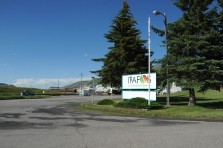Search Results: phosphate
View search results on mapThe Conda Phosphate Operation produces approximately 540,000 tons per year of mono-ammonium phosphate, super phosphoric acid, merchant-grade phosphoric acid and other specialty phosphate products for the fertilizer industry. It is supplied by nearby phosphate mines in the Permian-age sea bed deposit known as the Phosphoria Formation, located in southeastern Idaho.
This is a large phosphate storage terminal on the Mississippi River, supplying the agricultural regions of the upper Midwest with phosphates. The processed powdery substance, critical to industrial agriculture, is mined and processed at Mosaic’s facilities in central Florida. Next to the terminal to the north is a nitrate fertilizer terminal, owned by CF Industries, the nation’s largest supplier of nitrogen, manufactured primarily at gas plants in Louisiana.
Nutrien, the nation’s second largest phosphate fertilizer producer, operates several facilities that further refine and blend products, including the Florence Rainbow Granulation Facility in Alabama, across the river from the government’s historic fertilizer development center at Muscle Shoals.
The privately held Trademark Nitrogen Corporation operates one nitrogen plant, in an industrial park in Tampa, Florida, which supplies highly concentrated ammonium nitrate to explosives companies like Dyno Nobel. Tampa is a major nitrate and phosphate products port, with an ammonia pipeline which connects shipping terminals and plants at the port of Tampa to phosphate production plants 20 miles east of the city, in the Bone Valley.
In addition to its large phosphate mines and plants in Idaho and Wyoming, Simplot operates two small fertilizer plants in the midst of agricultural production in the central valley of California. The plant in Lathrop is at the north end of the valley, near the port of Stockton, and produces a variety of ammonium phosphate fertilizer products directly to local agricultural suppliers.
PCI Nitrogen operates a plant in Pasadena, Texas, the heart of the densest petrochemical production center in the country. Though focused on nitrogen now, this was a former phosphate facility, built in WWII, and operated by the explosives company Olin for many years, followed by Mobil, Agrifos, Rentech, and now PCI. Nitrogen and phosphate production (the N and P of NPK, the three basic elements of industrial agriculture) are chemically closely related, and sometimes share facilities.
Nutrien, the nation’s second largest phosphate fertilizer producer, operates several facilities that further refine and blend products, including the Marseilles Phosphate plant, on the Illinois River, west of Chicago.
Nutrien, the nation’s second largest phosphate fertilizer producer, operates several facilities that further refine and blend products, including this upgrading plant in Joplin, Missouri.
Nutrien, the nation’s second largest phosphate fertilizer producer, operates several facilities that further refine and blend products, including the Weeping Water Phosphate plant in Nebraska.
Nutrien, the nation’s second largest phosphate fertilizer producer, operates several facilities that further refine and blend products, including Americus Rainbow Granulation Facility in Georgia, which it acquired from Agrium.
Scattered around the country are a number of former phosphate plants in limbo, or orphaned in decay, like the Mississippi Phosphates company site in Pascagoula, Mississippi. Diammonium phosphate fertilizer was produced here from the 1950s to 2014, when the company went bankrupt. A $12 million fund that had been set aside to address the remediation quickly ran out. Two phosphogypsum stacks ceased to be managed, and millions of gallons of acidic liquid wastes flowed into the bay.
ICL Performance Products manufactures phosphate fertilizer products in Lawrence, Kansas, using raw materials from other suppliers. The plant is a former FMC phosphate products plant, now operated by the Israeli company ICL.
ICL Performance Products operates this plant at Carondelet, Missouri, which was formerly operated by Monsanto. ICL makes fertilizers, food products, and engineered materials, based from its origins as an Israeli company extracting minerals from the Dead Sea.
For more than 50 years, the FMC plant in Pocatello was the largest elemental phosphate plant in the USA, and was fed by local phosphate mines, until it was torn down in 2001. The site is now a series of closely monitored gypstacks and waste piles, some of which contain the remains of the buildings and chemical rail cars.
